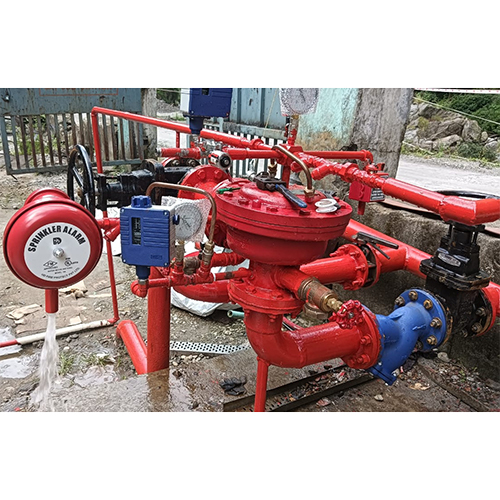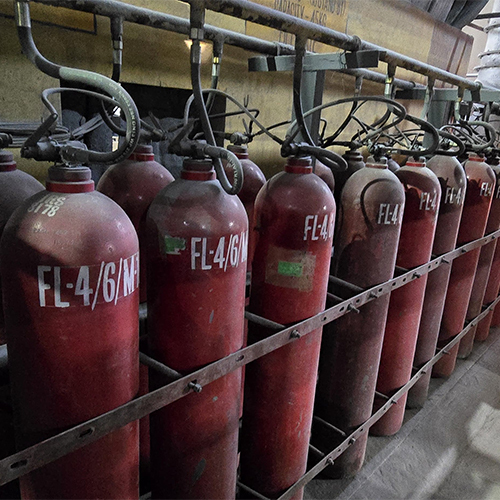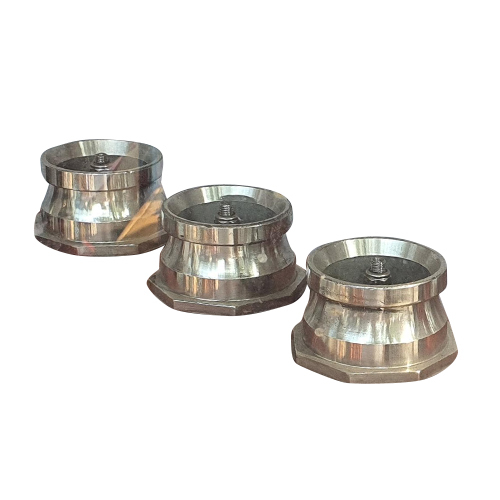Fire sprinkler system is one of the most trusted, dependable and essential fire security and safety device for offices, commercial buildings, educational institution, public buildings etc and designed to prevent and protect people and property from devastating fires situations. This system responds to a fire by automatically releasing water to extinguish or control the flames. The temperature at which a fire sprinkler activates is a critical aspect of its design, tailored to respond effectively to fire without causing false activations. There are some important aspects with this system that is better known to the proposed installer for appropriateness in its installation. Improper installation can render the entire investment as a complete waste.
In general a sprinkler is made to covers upto 200 square ft for areas with light hazards, 130 square feet for ordinary hazards, and 90-130 square feet for extra hazards and are placed 3 mtrs apart Depending on the system and occupancy it usually discharges pressurized water between 50 to 100 LPM, depending on the type of sprinkler head, water pressure, system design and occupancy. Usually a single sprinkler takes care of any fire situation, but under extra ordinary circumstances it is anywhere between 2 to 4 sprinklers that puts off any size of fire. Some have the feeling that all sprinklers get activated together which is not the case. It is only the ones that had achieved the rated burst temperature that gets activated.
A typical sprinkler head consists of the following key components:
- Deflector: That directs water in a uniform pattern over a large area.
- Heat-sensitive element: This is either a glass bulb filled with a glycerin-based liquid or Alcohol, both designed to break at a specified temperature.
- Orifice seal: that blocks water flow until the heat-sensitive element activates or bursts.
When a fire generates heat, the temperature in the area rises. As the heat-sensitive element reaches its designated activation temperature, it either bursts (in the case of a glass bulb) or melts (for a fusible link), opening the orifice and allowing water to flow through the connected pipes. The deflector ensures the water is dispersed over the area to extinguish the fire. This Water based Fire Sprinkler system is effective for A-class of fires involving combustible items like wood, paper, plastic, cloth etc. It essentially cool the burning object by continuous spraying of water through the affected sprinkler heads which is connected to the pressurized pipeline thereby eliminating manual efforts and arrangements in fire fighting.
World-wide, it is proven to be a highly effective system in controlling and suppressing the fire automatically. It has been observed that over 96 percent incidences of fire are controlled by the sprinklers. According to NFPA (National Fire Protection Association), damages to commercial properties like retail stores, warehouses, offices, hospitals etc having a working fire sprinkler system, there are 60 percent lower damages to building and properties than where there was no fire sprinkler system installed. An active auto sprinkler system provides 24x7 protections to your property, minimizing injuries and irreversible costly damages.
It may be good for you to know that according to NFPA 13, The standard for the Installation of Sprinkler Systems categorizes buildings or parts of buildings into six occupancy hazard classifications, namely:
- Light Hazard
- Ordinary Hazard (Group 1)
- Ordinary Hazard (Group 2)
- Extra Hazard (Group 1)
- Extra Hazard (Group 2)
- Special Occupancy Hazard
Occupancies or portions of occupancies are further classified according to the quantity and combustibility of contents, the expected rates of heat release, the total potential for the energy release, the heights of stock piles, and the presence of flammable and combustible liquids.
The followings are some of the typical examples of the classifications that shall help you in knowing your type of fire risk:
- Churches
- Clubs
- Educational Buildings
- Hospitals and Nursing homes.
- Museums
- Offices, including data processing
- Residential
- Restaurant seating areas
- Theaters and auditoriums to name a few important ones.
Ordinary Hazard (Group 1)
- Automobile parking and showrooms
- Bakeries
- Beverage manufacturing
- Canneries
- Dairy products manufacturing and processing
- Electronic plants
- Glass and glass products manufacturing
- Laundries
- Restaurant service areas etc.
Ordinary Hazard (Group 2)
- Chemical plant
- Dry cleaners
- Libraries (large stack room areas)
- Machine shops
- Metal working
- Mercantile
- Paper and pulp mills
- Stages
- Textile manufacturing
- Tire manufacturing
- Carpentry areas
Extra Hazard (Group 1)
- Aircraft hangers
- Plywood and particle board manufacturing
- Printing Inks with low flashpoints
- Rubber works
- Sawmills
- Textile work
- Plastic foam upholstering
Extra Hazard (Group 2)
- Asphalt saturating
- Flammable liquids spraying
- Open oil quenching
- Plastics manufacturing
- Solvent cleaning
- Varnish and paint dipping
The main advantages of a sprinkler system are:
I. It can suppress or extinguish a fire before it spreads significantly, often reducing the need for firefighting efforts or cause less damage to the property. They are designed to activate automatically when a fire reaches a surrounding temperature of 68 degrees Celsius.
II. By extinguishing or controlling fires quickly, sprinkler systems minimizes property damage and protect occupants, leading to less severe outcomes compared to fires without sprinkler systems.
III. They enhance life safety by allowing more time for occupants to escape and reducing the amount of smoke and heat produced, which can sometimes be fatal.
IV. According to studies, buildings with sprinkler systems have significantly lower fire-related fatalities and property damage compared to those without. For example, NFPA reports that the presence of sprinklers reduces the likelihood of fire fatalities by about 83 percent.
V. Although the initial installation cost may be high, sprinklers often result in lower insurance premiums and reduced damage costs, thereby making them a cost-effective investment in the long run.
A fire sprinkler system consists of several key components, each playing a crucial role in fire detection and suppression. Here are our main components:
Sprinkler Heads: It is a Quartzite bulb that releases water when a fire or flame are detected. They are activated by its surrounding heat. The bulbs are usually filled with glycerin based liquids or Alcohol that expands with heat and gets shatters upon reaching its temperature. The color coding of the bulbs indicates the temperature at which it will burst. Typically for Fire system, two colored bulbs are used. Red colored having a rating of 68 degrees Celsius that is usually installed indoor and yellow colored having a rating of 79 degrees Celsius that are installed out door.
Piping: The network of pipes transport water from its source to the sprinkler heads. This includes both the main supply lines and branch lines that lead to individual sprinklers.
Water Supply: The system needs a reliable source of clean water that is adequately pressurized and of required quantum and flow rate. Dirty water can clog the sprinkler heads and delay its activation or may even cause failure.
Control Valves: These valves regulate the flow of water in the system. They are also used to isolate sections of the system for maintenance or to control the overall system operation.
Alarm System: Many fire sprinkler systems are integrated with an alarm system that alerts occupants and emergency services when the system is activated.
Flow Switches: These devices detect water flow in the system and can trigger alarms or notifications when a sprinkler head is activated.
Pressure Gauge: This component monitors the pressure within the system to ensure it is operating at the required levels for effective performance.
Backflow Preventer: This device prevents contaminated water from flowing back into the clean water supply, ensuring the safety of the water used in the system.
Each of these components works together to provide a comprehensive fire protection solution, ensuring quick response and effective fire suppression.
There are Four Types of Fire Sprinkler systems suitable for varied applications and comes with different temperature ratings, namely Wet pipe, Dry pipe, Pre-action, and Deluge. Each of these systems helps prevent flames from spreading and reduces fire damage. The main difference between these types of fire sprinkler systems is their applications and how they activate. Flash Point however undertakes integration job of only 3 of the following types:
Wet Pipe Fire Sprinkler System - whose pipes contain water and is the most common type of system suitable for Ordinary hazards. When a fire sprinkler reaches the designated temperature, it breaks the glass and helps release the pressurized water. They are typically installed in office buildings, warehouses, high-rise buildings etc.
Dry Pipe Fire Sprinkler System is filled with nitrogen or pressurized air. The air pressure holds a dry pipe valve closed, and prevents water from entering the system. When a fire sprinkler detects a sudden temperature increase it activates and the air pressure drops in the system. This causes the dry pipe valve to open and direct the water into the dry pipe fire sprinkler system. Then the activated fire sprinkler discharges the water. Since dry pipe fire sprinklers contain no water, they are ideal in areas subject to freezing temperatures. Unheated warehouses, parking garages, extreme cold areas going on minus etc are best suited for this.
Deluge Fire Sprinkler System is designed for High hazard facilities as the open style sprinkler heads can discharge water quickly. Unlike the other types of fire sprinkler systems, these sprinkler heads always remain open and activate all at a time. These systems also contain neither water nor pressurized air. Once a Detector detects smoke or heat, the deluge valve gets opened and sends water to all the fire sprinklers. This allows water to discharge from each sprinkler head. When highly combustible material catches on fire the flames can grow and spread immediately. That is why places like High volt Power Transformers, Storage Oil Dikes, CO2 cylinder Banks, aircraft Hangars, industrial Plants etc need a fast-acting Deluge fire sprinkler systems.
Also important is to know that there are Three Basic Types of Fire Sprinklers, namely:
Standard Response Sprinklers - that has the slowest activation time; temperature activation. These sprinklers 5mm thermal bulb or fusible link or Alcohol needs to reach a certain temperature to break the element and release its trapped water. As has been expressed above that only the particular fire sprinkler that reaches its temperature bursting point, activate. By spraying water on items in the immediate area these fire sprinklers prevent fires from spreading.
Fast Response Sprinklers that releases water higher on the ceiling to prevent fire spreading and flash-over. These sprinklers activate when its 3mm thermal bulb breaks after reaching a designated temperature. Light hazard applications have small amounts of combustible material hence use this type of fire sprinkler. It is most appropriate to install them in light hazard occupancies that include ordinary combustible and flammable liquids like paper, wood, gasoline, paints etc. In small amounts, these materials will produce a low-temperature fire. Typically, apartments, hospitals, hotels, offices etc. are considered for these fire sprinkler systems.
Open Fire Sprinklers, Unlike standard response or fast response sprinklers, they have no thermal element and their nozzles are completely open type. It operates by the actuation of a fire alarm initiating device to detect heat. The initiating devices sends a signal to the fire alarm panel which then activates the Deluge valve. Then the water flows out of every fire sprinkler nozzle. These types of fire sprinklers are used in high hazard occupancies where there is a lot of combustible material. When large amounts of these combustibles catch on fire, they produce a lot of heat and these fires can spread quickly. Transformers, Industrial and manufacturing type facilities are best suited for these open fire sprinkler systems.
WATER MIST SYSTEMS:
Water mist system - a fire suppression method that forms fine atomized water droplets. It helps in cooling the burning object, reducing oxygen level concentration through steam formation and expansions thereby creating a fog that helps in extinguishing the flames.
It has the following Benefits:
- Efficiency: It helps in extinguishing fire with significantly less water that the traditional sprinkler systems.
- Eco Friendly: For the fire fighting media being only water, they are less harmful to the environment than the chemical based suppression system.
- Versatility: It can be used on a wide range of fire hazard, including solid, liquid and gaseous fires.
- Safety: The fine droplets do not create a wet, slippery environment, and the mist is less likely to damage equipments compared to larger water droplets.
- Reduced Damage: By fast cooling and suppressing the flame, water mist systems minimize damage to structures and contents.



 Send Inquiry
Send Inquiry





